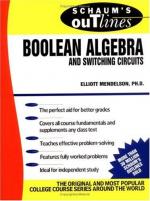|
This section contains 1,220 words (approx. 5 pages at 300 words per page) |

|
In 1847 George Boole (1815–1864), an English mathematician, published one of the works that founded symbolic logic. His combination of ideas from classical logic and algebra resulted in what is called Boolean algebra.
Using variables and symbols, Boole designed a language for describing and manipulating logical statements and determining if they are true or not. The variables stand for statements that are either true or false. The symbols +, * and − represent and, or, and not and are equivalent to the symbols [.logicaland], [.logicalor], and − used in the truth tables in logic. Although truth tables use T and F (for true and false respectively) to indicate the state of the sentence, Boolean algebra uses 1 and 0.
The relationship between Boolean algebra, set algebra, logic, and binary arithmetic has given Boolean algebra a central role in the development of electronic digital computers. Besides its many applications in the design of computers, it...
|
This section contains 1,220 words (approx. 5 pages at 300 words per page) |

|


